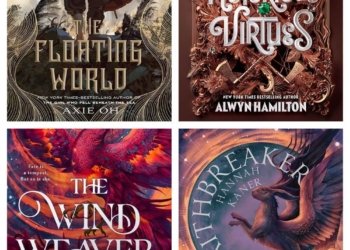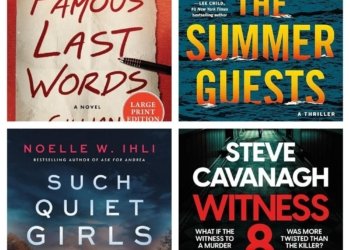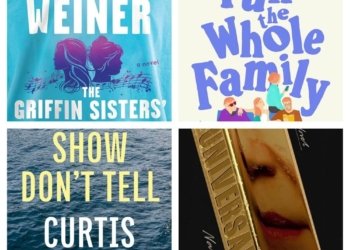No products in the cart.
A Conversation with Francesca McDonnell Capossela, a Women’s Fiction Author
Francesca McDonnell Capossela, author of "Trouble the Living", is a queer writer and Irish American dual citizen.
111
SHARES1.5k
VIEWSA queer writer and Irish-American dual citizen, Francesca grew up in New York City and holds an M. Phil from Trinity College Dublin. She wrote her undergraduate thesis about female agency in Nabokov’s Lolita and Proust’s In Search of Lost Time. Her first novel, Trouble the Living, is about a mother and daughter, set partially in Northern Ireland in 1997 and partially in 2016 Southern California. She lives in Brooklyn with her dog, Lyra.
Let’s get started with a quick rapid fire.

Q1. If you could be transformed into one mythological creature, which one would you choose?
A Leoglas-style elf..
Q2. What time do you usually go to bed at night?
Between midnight and 2am.
Q3. What are the least-likely three words someone would use to describe you?
Organized, trepidations, level-headed.
Q4. Where did you go on your last vacation?
I went to Maine to visit my girlfriend’s family.
Q5. Would you rather find your dream job or win the lottery? You can’t do both.
I’ve already found my dream job, so win the lottery.
Q6. What is one thing you regret spending money on?
My two cartilage piercings, both of which have closed up.
Q7. What object do you misplace or lose the most?
My driver’s license. I’ve had to replace it at least four times this year, and it’s only September.
Q8. If you were a spy, what would be your codename?
Harry Styles.
Q9. What secret about the universe would you most want to learn?
What happens after death. And/or what women’s soccer players are dating each other. “I knew, I’d always known, that war was a woman’s thing.”Francesca McDonnell Capossela, Trouble the Living
Q10. What never fails to make you laugh?
The tiktok of the boy who calls his two moms “this one” and “other one.”
Q11. What was one “before” and “after” in your life?
I took a semester off in college to travel and write. When I came back, I felt like I knew who I was for the first time.
Q12. What do you think people misunderstand about you?
Mocking you is my love language.
It’s time for a more detailed conversation, Francesca.
You’ve answered our rapid fire so well, Francesca. Now, it’s time for our readers to know more about the person behind the book.
Q. Tell us about your journey.
Allegedly, at eighteen months I could “read” my picture books (meaning I’d memorized all the words). Since then, I’ve loved books. In high school, I fell in love with analyzing texts, talking about literary movements, studying great authors. The transition to writing felt fated. In the year after I graduated college, I would wake up early before my 9-5 job and go to a coffee shop to write. It was on those dark, shadowy mornings that Trouble the Living began to take shape, but it wasn’t until I moved to Ireland for grad school that it fully found its legs. It’s been about five years since I started writing this novel, and now it’s finally out in the world.
Q. So, what books have you read more than once in your life?
I love to reread, so it’s a long list. But a few notables: Lolita, Ulysses, Middlemarch, all the Harry Potter books, The Golden Compass, Milkman by Anna Burns, The Great Gatsby, To the Lighthouse, Sula, Recitatif, My Brilliant Friend, Outline by Rachel Cusk, Giovanni’s Room, Invisible Man by Ralph Ellison, Notes from Underground, Pride and Prejudice, a lot of Shakespeare.
Q. Interesting. Who has been the biggest supporter of your writing?
My parents. They’ve read probably every word I’ve ever written, from overly sexual poetry to overly honest essays about themselves. And they’ve supported me the whole time. My dad is one of the first people I ask for feedback on my work. I ask my mom too, but she’s better at praise than constructive criticism. My mom and I have very similar sensibilities.
Q. Do you hide any secrets in your books that only a few people will find?
Not intentionally, but they’re definitely there. I’m always worried someone will be angry at me for stealing some story they told me and planting it on a character. And then there are certain characters for whom I’ve used a real-life model, so I’m always curious to see if they will recognize pieces of themselves. Once in a while, I let someone close to me name a character, so that’s fun too. “I felt then that I was not a real girl. I was an imposter, plucking my eyebrows to look like them. My hair never smelled sweet when I got out of the shower. I did not know to think about my legs, to wonder at their length or smoothness, to clear them of hair each morning. My mind was not used to female pathways of thought.”Francesca McDonnell Capossela, Trouble the Living
Q. Now comes the most anticipated question that every author must answer. How do you process and deal with negative book reviews?
I’ve been lucky (or I’m just not famous enough) to not have gotten very negative reviews. But of course I see bad ratings on GoodReads once in a while. I try not to read them, or to read the good ones straight after.
Q. What comes first for you — the plot or the characters — and why?
It’s hard for me to separate the two. The plot is the outcome of characters being themselves; the characters are the people who their actions demand them to be. I suppose it’s usually a feeling––or one action––that comes first, and then I start to think about how a person would come to that action in the first place and who that person would be. And then the fallout of that––which is the rest of the plot––comes as that person begins to navigate their choice. For Bríd in Trouble the Living, that choice is joining the IRA. Once I knew she would do that, I started to think about what kind of person she would have to be to make that decision.
Q. How do you develop your plot and characters?
I pivot between trying to understand what a character would have to do, given who they have been up until that moment, to then thinking about who they are now that they’ve done this thing. The best types of actions are actions that change characters in some way. So Bríd has to join the IRA because of who she is at that moment, but then the question becomes how does that decision change her? And the answer is that it changes her pretty fundamentally; it shapes the rest of her life. As her character develops, the plot is forced along. If you carefully consider who your character is, the plot is often inevitable; there is only one thing they can do that’s true to their nature.
Q. You got 100 points. You need to divide them on the basis of how relevant and important they are to you as a reader and a writer for your book or someone else’s as a reader. Your options are Plot/Story, Book Cover, Marketing, and, Reviews.
Before I read a book, I can’t help but be seduced by the reviews and the book cover. I generally, as a reader, find too much marketing a turn-off. But I do look at what writers I admired have said. Then, I read the first page, and see if it speaks to me. Sometimes, even if it doesn’t, I push through because I trust what I’ve heard about it. But once I’m about halfway through a book, I stop caring about anything except the story and the dialogue. And of those things, the dialogue is probably more important to me. I can suspend disbelief for a lot of stories, but I can’t for bad dialogue. So, when I’m halfway through a book my points would look like Story: 45, Dialogue: 55.
When I’m writing, I think it’s the inverse: Story 55, Dialogue 45. The story is harder to edit down the line, whereas the dialogue can always be sharpened. Of course, I care about reviews and marketing and the cover, but I care about that as an author not as a writer. As a writer, my only job is the manuscript.

Q. So, now, about your book. Talk to us about it. No major spoilers.
Trouble the Living started with a burning question: how much can we really know our mothers? I was thinking a lot about the ways in which mothers and daughters can be extraordinarily close––closer, often, than they are with anyone else in the world––and yet their relationships can be full of tension, secrets, lies. I was also thinking about the ways in which mothers’ pasts are often hidden from their daughters. The women they are before they have children are completely obliterated; all that’s left of them is “mom.”
These questions led to Bríd, whose past is not only annihilated by motherhood but is actively hidden from her daughter. Even her real name is a secret from Bernie. But, somehow, despite that, Bernie is the person closest to her in the world: Bernie is her world. Meanwhile, Bernie is sixteen, coming of age, trying to figure out who she is, and through that, she is starting to wonder who her mother really is. Where they come from. Who her grandparents are. What her mother is so afraid of.
Ultimately, the novel follows these two women: Bríd from her teen years in 1997 Northern Ireland during the Troubles to her forties, where she’s raising Bernie in Southern California. Bernie, age sixteen, living outside of LA, exploring her feelings for her best friend, and trying to understand her mother. They are both, it turns out, very capable of violence, of anger, and of love.
Q. What part of the book did you enjoy the most while writing?
The ending was so satisfying to write. The final scene fell into place in the first draft and hardly changed at all since then, but the few scenes before the final scene did shift, and I absolutely love them now. We get these moments of mother-daughter-grandmother connection, some of which are pretty fraught, most of which are difficult, bloody, and vulnerable. But it’s a full-circle ending for these characters.
Q. What is your kryptonite as a writer?
Similes! I use way too many of them. I also overuse the words “feel”, “heat”, and “blood.” Apparently, my characters are always nauseous.
Q. Would you and your main character get along in real life?
Both of my characters are very loyal to the people they love and very wary of outsiders, so neither of them makes friends easily. They’re also both difficult people––somewhat self-involved, stubborn, reckless––but then again, so am I. I think Bernie would be fascinated to meet her creator; I think Bríd would be extremely skeptical.
Q. What is your writing process like? Are you more of a plotter or a pantser?
It varies. I know the endings of my books (or at least I think I do) fairly early on in the process. But I’m often experimenting until I figure out the best way to get there. And often the characters surprise me, or don’t do what I want them to do. Sometimes, they have chemistry with each other when I didn’t mean them to. Sometimes, they lack chemistry and I have to try something else. I definitely don’t write with a full outline, but I do have certain moments that I know need to be in the story, and I work towards those.
Q. Let’s talk about the process of writing. Do you do research while writing a book to add more authenticity? What kind of research?
Because I didn’t grow up in Ireland and because I’m much younger than Bríd (16 years, to be exact), I did a lot of research to flesh out her childhood, especially related to the violence of the Troubles. I read lots of history books about that time period (and the history of colonization and partition in Ireland), including Provos by Peter Taylor, Killing Rage by Eamon Collins, The Border by Diarmaid Ferriter, and Say Nothing by Patrick Radden Keefe.
At some point, though, my grad-school advisor Eoin McNamee––who is a brilliant novelist who writes about the Troubles––recommended that I stop reading history books and start focusing on the art made during and about that time. Fiction, poetry, photography: he said that was where I would learn the most about what it meant to be alive in 1997 Northern Ireland. So that’s where I shifted my focus, and with it, I concentrated on the humanity of that time: the bathing suits and sunglasses, the food at weddings, the music they danced to.
Q. What was your hardest scene to write?
Trouble the Living is a book about women, about the particularities of womanhood, about the relationships between women, about women’s violence. And so the men in this book––particularly Bríd’s father and Bernie’s father––were strangely difficult to write. I had to make sure they were full characters, with their own motivations and needs, but I was thinking so much about the roles of women that men’s experiences felt alien. They lacked an awareness of the issues at the heart of the novel and that made them difficult for me to empathize with, and difficult for me to get inside their heads.
In the end, I really like how these men turned out. They’re both sort of cowed by their wives’ anger, which felt true to their relationships. In the same way that the women in this book are struggling against societal gender roles, the men are also trapped by expectations of masculinity.
Q. Well, this has been great. Now, before we wrap this up, do you have any suggestions to help someone become a better writer? If so, what are they?
Read more than you currently do. Finish your draft. Find writers you trust to swap work with (and to complain with). If you’re wondering if you should delete something, you probably should. Deleting is more than half of writing. There will be days and weeks and months when you won’t write, don’t panic. Claire Keegan taught me this: by the middle of every story, your character should wish they can go back in time and undo what they have done. All good stories are about the heartbreak of not being able to change the past.
Related Posts
A Conversation with Melanie Shawn, a Romance Author
NYT & USA TODAY bestselling author Melanie Shawn lives in Southern California and is a mama to two adult people...
10 Most Anticipated Fantasy Books of Spring 2025
As the seasons change and we step into the vibrant energy of spring 2025, readers everywhere are eagerly anticipating fresh...
10 Most Anticipated Thriller Books of Spring 2025
Are you a bookworm who thrives on heart-pounding suspense and unexpected twists? Get ready to mark your calendars and clear...
8 Most Anticipated Contemporary Books of Spring 2025
Are you a bookworm always on the lookout for the next big literary gem to dive into? Well, get ready...
About Us

Trenzle
Where Trends are made and discovered
Trenzle is your official source of discovering the latest people, work, and ideas that deserve to trend. Discover Authors and their books, Creators and their work, People and their opinions, and Stories from around the globe.
Learn more
Latest Posts
A Conversation with Melanie Shawn, a Romance Author
April 19, 2025
10 Most Anticipated Fantasy Books of Spring 2025
April 18, 2025
Categories
© 2023 Trenzle - Online Author News & Magazine









